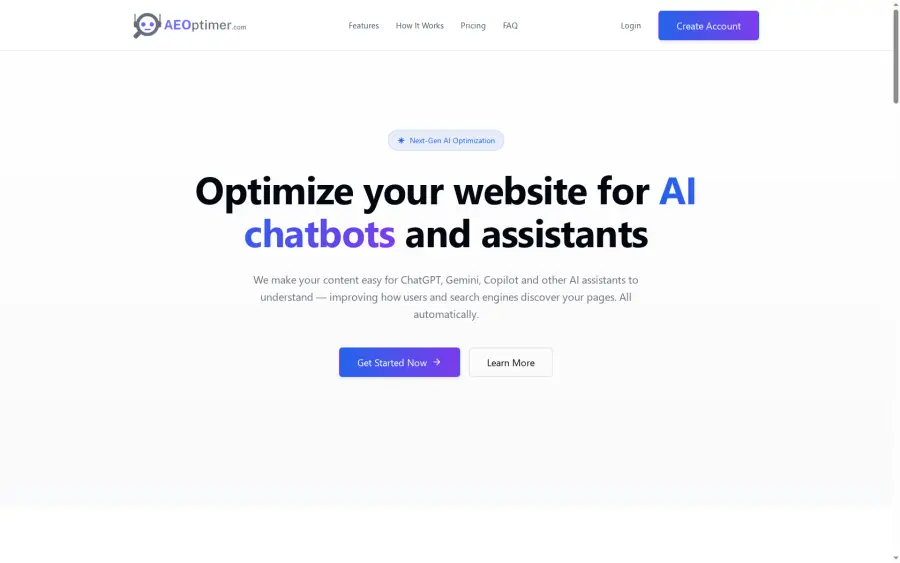7 Essential Steps for a Website Content Update Checklist

Did you know that over 60 percent of website content goes untouched for years, risking credibility and lost visitors? Outdated pages can drive users away while harming your search rankings. By taking a fresh look at your digital content, you can uncover hidden issues, improve site performance, and keep your online presence relevant in a fast-moving landscape.
Table of Contents
- 1. Audit Existing Website Content For Relevance
- 2. Update Keywords To Match Latest Search Trends
- 3. Enhance Structured Data For Better Ai Recognition
- 4. Optimize Meta Tags And Descriptions Regularly
- 5. Review And Refresh Outdated Information
- 6. Check Sitemap And Internal Links For Accuracy
- 7. Implement Ongoing Automated Content Updates
Quick Summary
| Takeaway | Explanation |
|---|---|
| 1. Conduct a comprehensive content audit | Review all website content to identify what is relevant and effective. This helps align with user needs and business goals. |
| 2. Regularly update keywords | Analyze and refresh keywords to match current search trends and improve visibility in search results. |
| 3. Enhance structured data | Implement structured data markup to help search engines and AI systems understand your content better, leading to improved indexing. |
| 4. Optimize meta tags frequently | Craft unique, engaging meta tags and descriptions that accurately represent page content for better click-through rates. |
| 5. Schedule periodic content reviews | Regularly check and refresh outdated information to maintain user trust and ensure your website remains relevant. |
1. Audit Existing Website Content for Relevance
A content audit is your strategic roadmap to understanding what works and what doesn’t on your website. Performing a comprehensive review of your existing content helps you make informed decisions about your digital strategy.
According to research from Stanford University, a content audit allows you to assess the size and relevance of your site. This process enables you to plan targeted updates by identifying which content to retain, revise, or completely remove.
To conduct an effective audit, start by creating a detailed inventory of all your website pages. Evaluate each piece of content through these critical lenses:
- Accuracy of information
- Alignment with current business goals
- Relevance to your target audience
- Search engine performance
- User engagement metrics
As Yale’s web resources highlight, the ultimate goal is ensuring that all content precisely matches your audience’s needs and organizational objectives. This isn’t just about cleaning house it’s about creating a more strategic and effective online presence.
Pro tip: Use analytics tools to gather quantitative data about each page’s performance. Look for content with low pageviews, high bounce rates, or outdated information as primary candidates for revision or removal. By systematically reviewing and updating your content, you’ll maintain a dynamic website that continues to serve your audience effectively.
2. Update Keywords to Match Latest Search Trends
Search trends evolve rapidly and your website’s keyword strategy must keep pace. Keyword optimization is not a one time task but an ongoing process of understanding and adapting to how your target audience searches online.
Research from the University of Washington emphasizes that incorporating relevant keywords ensures your website remains aligned with changing search behaviors and improves overall visibility in search results. This means regularly analyzing and updating the language you use to match what potential visitors are actually typing into search engines.
Practical keyword research strategies include:
- Using free tools like Google Trends
- Analyzing search console data
- Monitoring industry specific forums
- Reviewing competitor content
- Checking social media conversations
As recommended by University of Maine’s content guidelines, regularly updating keywords enhances search engine optimization. This approach makes your content more discoverable and increases the likelihood of attracting your target audience.
A smart approach is to review your keywords quarterly. Look for emerging terms users are searching related to your industry. Pay attention to long tail keywords that might reveal specific user intent. Remember that keyword optimization is about understanding user language not just stuffing content with random terms.
3. Enhance Structured Data for Better AI Recognition
Structured data is the secret language that helps AI and search engines understand your website’s content with crystal clarity. Adding structured data markup transforms your web pages from simple text into intelligible information packets that machines can easily interpret.
According to research from Kansas State University, implementing structured data markup helps search engines and AI systems better understand your content. This leads to improved indexing and potentially richer search results that can dramatically increase your website’s visibility.
Key types of structured data to implement include:
- Schema.org markup
- JSON-LD annotations
- Rich snippet configurations
- Organization and person details
- Product and service information
The University of Illinois Library highlights that structured data enhances the clarity and organization of website information. Think of it like creating a detailed roadmap for AI systems to navigate your content efficiently.
To get started, use free tools like Google’s Structured Data Markup Helper. Begin with your most important pages and gradually expand coverage. Test your implementation using Google’s Rich Results Test to ensure proper configuration. Remember that good structured data is about precision clear communication and making your content as accessible as possible to both human readers and AI systems.
4. Optimize Meta Tags and Descriptions Regularly
Meta tags and descriptions are your website’s first impression in search results and act like digital billboards that attract potential visitors. Crafting compelling meta content is an art of balancing information and engagement.
According to research from Georgia Tech, regularly reviewing and updating meta tags ensures they accurately reflect page content and can significantly improve click-through rates from search engine results. This isn’t just about technical optimization its about creating an inviting entry point for users.
Key elements to focus on when optimizing meta tags include:
- Unique descriptions for each page
- Inclusion of primary keywords
- Clear and concise messaging
- Accurate representation of page content
- Compelling call to action language
Research from Western Kentucky University emphasizes that optimizing meta tags with relevant keywords and succinct summaries enhances both SEO performance and user engagement. Aim to write descriptions that answer the user’s potential question before they even click.
A practical approach is to review your meta tags quarterly. Use tools like Google Search Console to track performance and make data driven adjustments. Remember that good meta descriptions are like elevator pitches for your webpages concise, informative and designed to spark curiosity.
5. Review and Refresh Outdated Information
Website content is like a living organism that requires constant nurturing and attention. Keeping your content current is not just about looking professional it is about maintaining user trust and delivering genuine value.
Research from the University of Louisiana emphasizes that regular website updates ensure all information remains current and accurate. This ongoing process directly impacts user engagement and your website’s perceived reliability.
Critical areas to review for outdated content include:
- Statistical information
- Product or service descriptions
- Team member profiles
- Historical data and references
- Copyright years
- Contact information
According to Appalachian State University, periodic content reviews help identify and remove redundant information while enhancing the overall user experience. Think of this process as digital housekeeping that keeps your online presence sharp and relevant.
A practical approach is to schedule quarterly content reviews. Set calendar reminders to systematically check each section of your website. Use analytics tools to identify pages with declining traffic which might signal outdated content. Remember that users appreciate websites that demonstrate commitment to accuracy and up to date information.
6. Check Sitemap and Internal Links for Accuracy
Your website’s sitemap is like a comprehensive roadmap that guides both users and search engines through your digital landscape. Maintaining a precise and functional sitemap is crucial for ensuring smooth navigation and optimal search engine performance.
According to Stanford University’s research, utilizing your website’s sitemap to audit content helps ensure that all internal links are accurate and functional. This process directly impacts your site’s usability and search engine optimization efforts.
Key aspects to examine during your sitemap review include:
- Broken or dead internal links
- Outdated page redirects
- Missing important pages
- Incorrect page hierarchies
- Duplicate content entries
Research from UC Davis emphasizes that regularly checking your sitemap and internal links prevents navigation issues and enhances overall user experience. Think of this process as performing routine maintenance on your website’s infrastructure.
Practical tools like Google Search Console and specialized link checking software can automate much of this process. Set a quarterly schedule for comprehensive link audits. Pay special attention to recently updated or removed pages that might disrupt your site’s interconnected structure. A well maintained sitemap not only improves user experience but also signals to search engines that your website is professional and meticulously managed.
7. Implement Ongoing Automated Content Updates
Automated content management represents the future of website maintenance transforming how businesses keep their digital presence fresh and relevant. Implementing intelligent update systems eliminates the tedious manual process of constantly reviewing and refreshing website content.
According to research from Kansas State University, automating content updates helps maintain a dynamic and engaging website while reducing the risk of outdated information. This approach ensures your digital platform remains current without consuming excessive staff time and resources.
Key automated update strategies to consider include:
- Scheduled content refreshes
- Dynamic data feed integrations
- Automated keyword optimization
- Intelligent content tagging systems
- Periodic link validation
Research from the University of South Carolina highlights that implementing automated content management systems facilitates regular updates without manual intervention. Think of these tools as your digital caretakers continuously working to keep your website polished and informative.
Start by identifying content areas most suitable for automation such as blog posts industry statistics or recurring news sections. Leverage tools that offer machine learning capabilities to intelligently suggest and implement updates. The goal is creating a self maintaining website that adapts and evolves with minimal human oversight.
Below is a comprehensive table summarizing the key strategies and considerations for enhancing website content discussed in the article.
| Strategy | Key Actions | Expected Results |
|---|---|---|
| Audit Existing Content | Create content inventory, evaluate for accuracy & relevance, use analytics tools. | Inform digital strategy, identify content to retain, revise, or remove. |
| Update Keywords | Use tools like Google Trends, analyze search trends, and check competitor content. | Improved search visibility, alignment with search behaviors. |
| Enhance Structured Data | Implement Schema.org, JSON-LD, and use Google’s tools to test. | Better AI recognition, increased search visibility. |
| Optimize Meta Tags | Craft unique, keyword-rich, engaging descriptions. | Improved click-through rates, better SEO performance. |
| Review Outdated Information | Regularly update statistical data, contact info, and team profiles. | Maintained user trust, enhanced user engagement. |
| Check Sitemap & Links | Audit for broken links, outdated redirects, and ensure accurate hierarchies. | Enhanced usability, improved SEO. |
| Automate Content Updates | Use dynamic feeds, automated tagging, and intelligent systems. | Continual freshness, reduced manual workload. |
Keep Your Website Content Updated Effortlessly with AEOptimer
Updating your website content following essential steps like auditing relevance, refreshing keywords, and enhancing structured data can feel overwhelming. The challenges of maintaining accurate information, ensuring AI recognition, and regularly optimizing meta tags add complexity that quickly consumes valuable time and resources. If you want to stay ahead in AI-driven search results and keep your website visible without the hassle of manual updates, streamlined automation is the key to success.

Discover how AEOptimer automates your content updates by crawling and enhancing your pages monthly. Our platform integrates powerful features like automatic sitemap detection, structured data markup, and AI-friendly content improvements without changing your site’s appearance. Don’t let outdated content or missed keywords hold you back. Visit AEOptimer today to empower your website with continuous optimization and watch your visibility climb in AI assistant results while saving time and effort.
Frequently Asked Questions
How do I conduct a content audit on my website?
Start by creating a detailed inventory of all your website pages. Evaluate each piece of content for accuracy, relevance to your audience, and alignment with current business goals, ensuring to identify content that needs to be retained, revised, or removed.
What tools can I use to update keywords for my website?
Utilize free tools like Google Trends and Google Search Console to analyze current search trends. Regularly monitor industry forums and social media conversations to identify emerging keywords that align with your content.
How often should I refresh my website content for accuracy?
Aim to schedule content reviews quarterly to check for outdated information such as statistics, product details, and contact information. This ensures that your content remains current and trustworthy for your audience.
What types of structured data should I implement on my website?
Focus on implementing Schema.org markup and JSON-LD annotations, which help search engines better understand your content. Start with the most important pages and gradually expand coverage to improve your website’s visibility in search results.
How can I optimize my meta tags for better performance?
Craft unique meta descriptions that include primary keywords and accurately represent your page content. Regularly review these tags at least once every quarter to improve your site’s click-through rate and user engagement.
What steps should I take to regularly check my sitemap and internal links?
Conduct a thorough review of your sitemap at least every quarter to identify broken links and outdated redirects. Use link-checking software to streamline this process and ensure a smooth user experience on your website.





